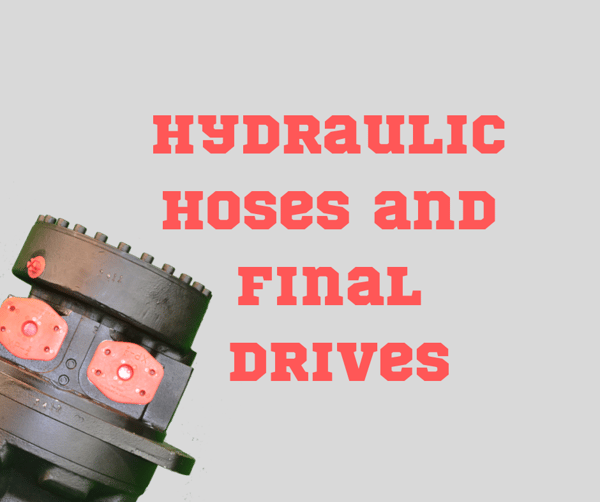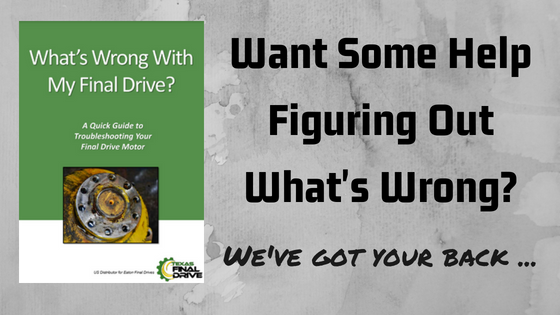Hydraulic lines, whether they are stiff pipes or flexible hoses, act as a key part of the circulatory system for your hydraulic machines. Here are some hints and tips for dealing with the hydraulic hoses that connect your final drive to your machine’s hydraulic system.

Here are some other blog posts you might want to check out ...
- Causes of Hydraulic Hose Failure on Heavy Equipment
- Tips for Installing a Final Drive
- 6 Cost Savings Ways to Manage Fleet Maintenance
Basics of Hydraulic Hoses
Hydraulic hoses are designed to withstand tremendous amounts of pressure. They typically have an inner lining made of strong synthetic rubber that can handle significant pressure while protecting the hose itself from petroleum-based hydraulic fluids. The next layer is going to be fiber-braid reinforced synthetic rubber to provide added strength without compromising flexibility. The final layer is an elastomer that also aids with flexibility while protecting the interior layers from cuts and abrasion.
Removing the Hydraulic Hoses
When pulling your final drive, we highly recommend marking the hoses so that you can identify where they go later. Making a simple mark with some chalk or wrapping some colored wire around the hose seems to work very well. This can make it much easier to quickly reattach the hoses when you are ready to reattach the final drive.
Once a hose has been detached from a port, make sure that the end of it are plugged or covered. This prevents dirt or other debris from getting inside the hose and helps to minimize how much hydraulic fluid spills (some spillage is unavoidable). We also recommend wiping the hose fittings clean once you have them securely plugged. Failure to secure the hose openings can result in hydraulic contamination that can seriously damage your final drive motor.
Inspecting the Hoses
After you remove the final drive, check the hoses for signs of rubbing or abrasion. Abrasive damage is a major cause of hydraulic hose failure. You can purchase a protective sleeve or wrap for the hose, or reroute it so that it is no longer in contact with the source of the abrasion. Also, check for any cuts or gouges. This type of damage will eventually lead to leaks and can cause major problems for your final drive motor.

Reattaching the Hoses
Avoid twisting the hose, because once it is under pressure that twisting can weaken it and lead to leaks and similar damage. Also, avoid 90-degree angle bends in the hose. Not only can that result in a loss of pressure and velocity, but it can put excessive stress on the hose in the area of the bend and lead to failure.
.jpg?width=277&name=Hoses_and_fittings_from_US_Navy_081105-N-2456S-004_Aviation_Structural_Mechanic_Airman_Marty_Baum_connects_hydraulic_lines_to_the_hydraulic_drive_unit_(cropped).jpg)
If You Are Having Hose Issues
It is a good idea to observe the hoses leading to the final drive while they are under pressure, if possible -- hoses shorten under pressure, so what may look like a nice, loose bend when you remove the final drive can look very different under pressure.
If you see one of the hoses making a tight bend, then you may want to consider replacing that hose with one that is longer. Tight bends will lead to hose damage, and can adversely affect the pressure and flow in the hose, which in turn can negatively affect the performance of your final drive motor.
Also check carefully for areas where the hose may be rubbing against a sharp edge or corner while the machine is running. As mentioned earlier, you can buy a protective cover for your hoses to protect them from this type of damage. If possible, you could try rerouting that hose away from such problem areas, but we realize that isn’t always feasible.
U.S. Navy photo by Mass Communication Specialist 3rd Class John Suits [Public domain], via Wikimedia Commons
Conclusion
Hydraulic hoses carry the hydraulic fluid that makes your final drive motors run. Be careful when detaching them, and periodically check to make sure they are in good condition. Watch out for cuts and tight bends, and be on the lookout for any sharp edges they may be rubbing against during operation.
Texas Final Drive is your partner in providing new or remanufactured final drive hydraulic motors from a single mini-excavator to a fleet of heavy equipment. Call today so we can find the right final drive or hydraulic component for you, or check out our online store to find your O.E.M. manufacturer brand motor now.


